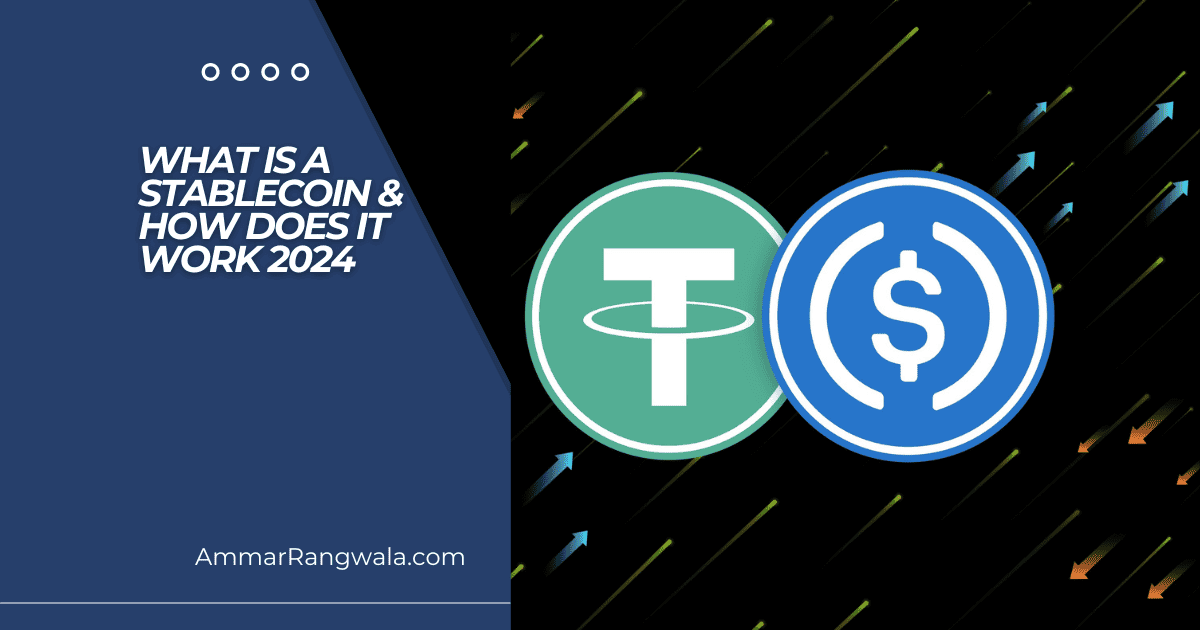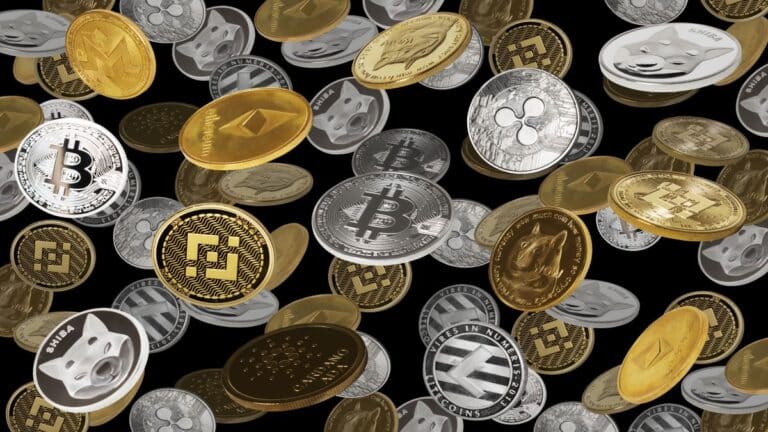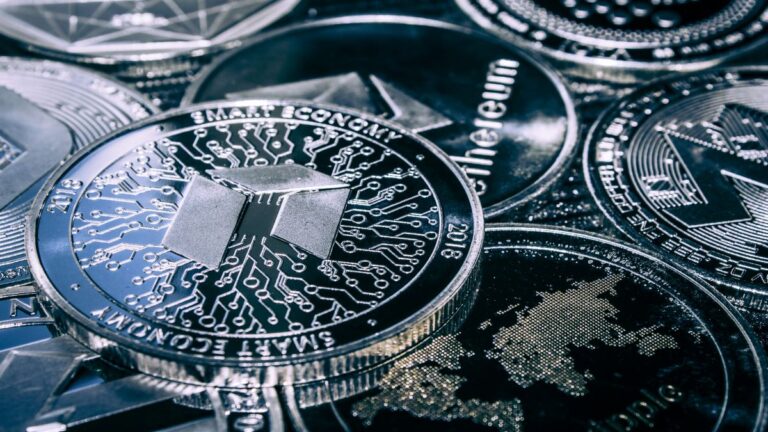What is a Stablecoin & How Does it Work 2024

Cryptocurrencies offer a decentralized, digital alternative to traditional currencies. However, their inherent volatility can cause heartburn for many investors. This is where stablecoins enter the picture, helping provide much-needed stability to the digital asset landscape.
These innovative digital assets peg their value to real-world assets like a fiat currency (think US dollars, Euros), commodity (gold), or even other cryptocurrencies. This “tether” helps them provide price stability to mitigate the high levels of volatility of most cryptocurrencies.
This blog post serves as your guide to stablecoins. We’ll explain how they work and explore their potential benefits and risks. So, whether you’re a seasoned crypto enthusiast or just curious about these intriguing assets, this is a great way to arm yourself with more knowledge.
What is a Stablecoin?
Fiat Backed Stablecoins
- These are the most common type, pegged directly to a fiat currency like the US dollar.
- Their value is typically backed by reserves of the corresponding fiat currency a custodian or consortium holds.
- Benefits: High stability, transparency, and regulatory compliance.
- Risks: Counterparty risk if the custodian loses or misuses the reserves.
Algorithmic Stablecoins
- These use algorithms to adjust their supply and demand automatically, maintaining a peg to a fiat currency or other asset.
- They achieve this through buying and selling their tokens based on market fluctuations.
- Benefits: Potential for decentralization and censorship resistance.
- Risks: Complex design, potential for algorithmic vulnerabilities, susceptibility to market manipulation.
Crypto Backed Stablecoins
- These are pegged to another cryptocurrency, typically with a larger market capitalization like Bitcoin or Ethereum.
- The value is maintained through collateralization (locking other crypto assets) and dynamic mechanisms like minting and burning additional stablecoins.
- Benefits: Can leverage established crypto infrastructure diversification beyond fiat currencies.
- Risks: Volatility is inherited from the underlying crypto asset, resulting in the potential for collateral shortfalls.
Additional Notes
- Hybrid stablecoins exist, combining elements from different types, like DAI, which uses fiat and crypto collateral.
- The type of stablecoin you choose depends on your needs and risk tolerance. Consider factors like stability, transparency, decentralization, and potential risks before investing.
What are Popular Stablecoins?
1. USD USD Coin (USDC): A leading contender, USDC boasts backing from a consortium of financial institutions, ensuring transparency and trust. Each USDC is pegged to one US dollar held in reserve, offering stability and regulatory compliance. USDC is a fiat backed stablecoin.
2. Paypal USD (PYUSD): This newcomer, launched by the renowned Paypal platform, aims to simplify stablecoin usage for mainstream users. Directly integrated into the Paypal ecosystem, it eases buying, selling, and holding USDC stablecoin backed value within the familiar PayPal environment.
3. Gemini Dollar (GUSD): Founded by the Winklevoss twins, GUSD is regulated by the New York State Department of Financial Services, adding another layer of trust. Each GUSD is backed by 1 usd in insured US banks, catering to security-conscious individuals. GUSD would be considered a fiat backed stablecoin.
4. Tether Gold (XAUT): Unlike its more common sibling, Tether (USDT), Tether Gold offers a unique twist – a peg to physical gold bullion. Each XAUT represents one troy ounce of gold stored in vaults, appealing to investors seeking diversification beyond fiat currencies. Tether Gold would be in the category of commodity backed stablecoins.
5. Tether (USDT): The most widely used stablecoin, Tether has faced controversy regarding its reserve backing. Despite its immense popularity, USDT’s opacity concerning its reserves raises concerns for some investors.
You can also learn about the market capitalization of these stablecoins on CoinMarketCap.
Benefits of Stablecoins
Taming the Volatility Rollercoaster: Traditional cryptocurrencies can fluctuate dramatically, making them risky for everyday transactions or as a store of value. Stablecoins, however, are pegged to real-world assets like fiat currencies or precious metals, resulting in significantly less volatility. This predictability makes them more suitable for everyday use, like paying for goods or services, without fearing sudden price drops.
Unlocking the DeFi World: The exciting world of decentralized finance (DeFi) allows users to borrow, lend, and earn interest on their crypto holdings. However, due to their stability, many DeFi applications require stablecoins as collateral or payment. By holding stablecoins, users can access a broader range of DeFi opportunities, potentially earning attractive returns while maintaining lower risk.
Hedging Against Inflationary Headwinds: As traditional currencies experience inflation, their purchasing power decreases. Stablecoins pegged to stable assets can offer protection against inflation, especially for users in countries with high inflation rates. While not a guaranteed hedge, some investors see stablecoins as a way to preserve the value of their assets over time.
Streamlining Cross-Border Transactions: Due to intermediaries and fees, traditional money transfers across borders can be slow and expensive. Stablecoins offer the potential for faster and cheaper cross-border transactions, leveraging blockchain technology for near-instantaneous settlements and potentially lower fees compared to traditional systems. This could revolutionize how individuals and businesses send and receive money internationally.
Risks and Considerations
Regulatory Uncertainty: The world of stablecoins currently exists in a regulatory grey area. Governments and financial institutions are still developing frameworks to oversee their issuance and usage. This lack of clear rules poses several potential risks:
- Sudden regulatory changes: Evolving regulations could disrupt established stablecoin ecosystems, potentially impacting their value and functionality.
- Limited consumer protection: Without robust regulations, stablecoin users may have limited recourse in case of fraud or mismanagement.
Counterparty Risk: Each stablecoin relies on a specific mechanism to maintain its peg to a real-world asset. This mechanism introduces counterparty risk, meaning the entity responsible for maintaining the peg may fail to do so. The type of risk varies depending on the stablecoin:
- The stablecoin could lose its peg if the issuer holding the reserve assets becomes insolvent.
- Some stablecoins rely on complex algorithms to adjust supply and demand, but potential flaws or manipulations could destabilize the system.
Technical Vulnerabilities: Like any software system, stablecoins are susceptible to technical vulnerabilities. Hackers could exploit these vulnerabilities to:
- Steal user funds: If security measures are compromised, hackers could gain access to and steal user holdings of stablecoins.
- Disrupt the peg: In some cases, vulnerabilities could be exploited to manipulate the stablecoin’s price, causing it to deviate from its intended peg.
Navigating the Risks
While these risks highlight the need for caution, understanding them allows you to manage your exposure effectively:
- Research thoroughly: Choose stablecoins backed by reputable entities with transparent practices and proven track records.
- Diversify your holdings: Don’t concentrate your crypto exposure solely on one or two stablecoins.
- Stay informed: Keep up-to-date with regulatory developments and technical updates around stablecoins.
- Store securely: Utilize secure wallets and follow best practices for managing your crypto assets.
How to Use Stablecoins
Buying and Selling
- Exchange Platforms: Many cryptocurrency exchanges, like Coinbase and Binance, directly purchase popular stablecoins using fiat currencies (USD, EUR) via bank transfers or debit/credit cards.
- Peer-to-Peer Platforms: Decentralized platforms like LocalBitcoins connect buyers and sellers directly, offering more payment options but potentially higher fees.
- Stablecoin Swaps: Platforms like Uniswap and Curve facilitate swapping between stablecoins, often with lower fees than exchanges.
Using in DeFi
- Earn Interest: Lend your stablecoins to others through DeFi platforms like Aave or Compound, earning passive interest based on demand.
- Borrow Funds: Utilize your stablecoins as collateral to borrow other cryptocurrencies or even fiat on platforms like MakerDAO.
- Stablecoin Liquidity Pools: Become a liquidity provider by depositing stablecoins into pools on DEXs, earning fees whenever tokens are traded.
- Stablecoin Payments: Some online merchants and payment processors accept stablecoins for purchases, offering faster and potentially cheaper transactions.
Storing Safely
- Hardware Wallets: The most secure option is storing your stablecoins offline on encrypted devices like Ledger or Trezor.
- Software Wallets: Convenient for smaller amounts, but consider reputable, established wallets with solid security features.
- Custodial Wallets: Exchanges hold your stablecoins, offering easier access but less control and potential security risks.
Summary
Key Takeaways
- Price Stability: Unlike traditional cryptocurrencies known for wild price swings, stablecoins aim to maintain a peg to a stable asset, often the US dollar. This reduces volatility, making them suitable for transactions and storing value.
- Efficiency: Stablecoins can facilitate faster and cheaper cross-border payments compared to traditional financial systems, potentially revolutionizing international transactions.
- Accessibility: They offer an entry point into the crypto world for those interested in the technology but wary of extreme price fluctuations.
Potential Risks
- Peg Failure: The mechanism maintaining a stablecoin’s peg can be complex and susceptible to errors or external events, potentially causing the coin’s value to deviate significantly from its target.
- Regulation: The regulatory landscape surrounding stablecoins is still evolving, and future regulations could adversely impact their functionality and value.
- Centralization: Depending on their design, some stablecoins may be reliant on centralized entities for maintaining their peg, raising concerns about transparency and censorship resistance.
Explore Responsibly
Stablecoins offer intriguing possibilities, but approaching them with caution is essential. Carefully consider your individual risk tolerance and investment goals before allocating any funds. Thoroughly research different stablecoin options, understanding their underlying mechanisms and potential vulnerabilities. Remember, the crypto ecosystem is inherently volatile, and stablecoins are not immune to risks.
Ammar has started several online businesses and is a blogger who loves providing quality content to help others. He is involved with affiliate marketing, domain names, NFTs, and cryptocurrencies. Check out my blog if you want to learn more about these areas and business in general.






